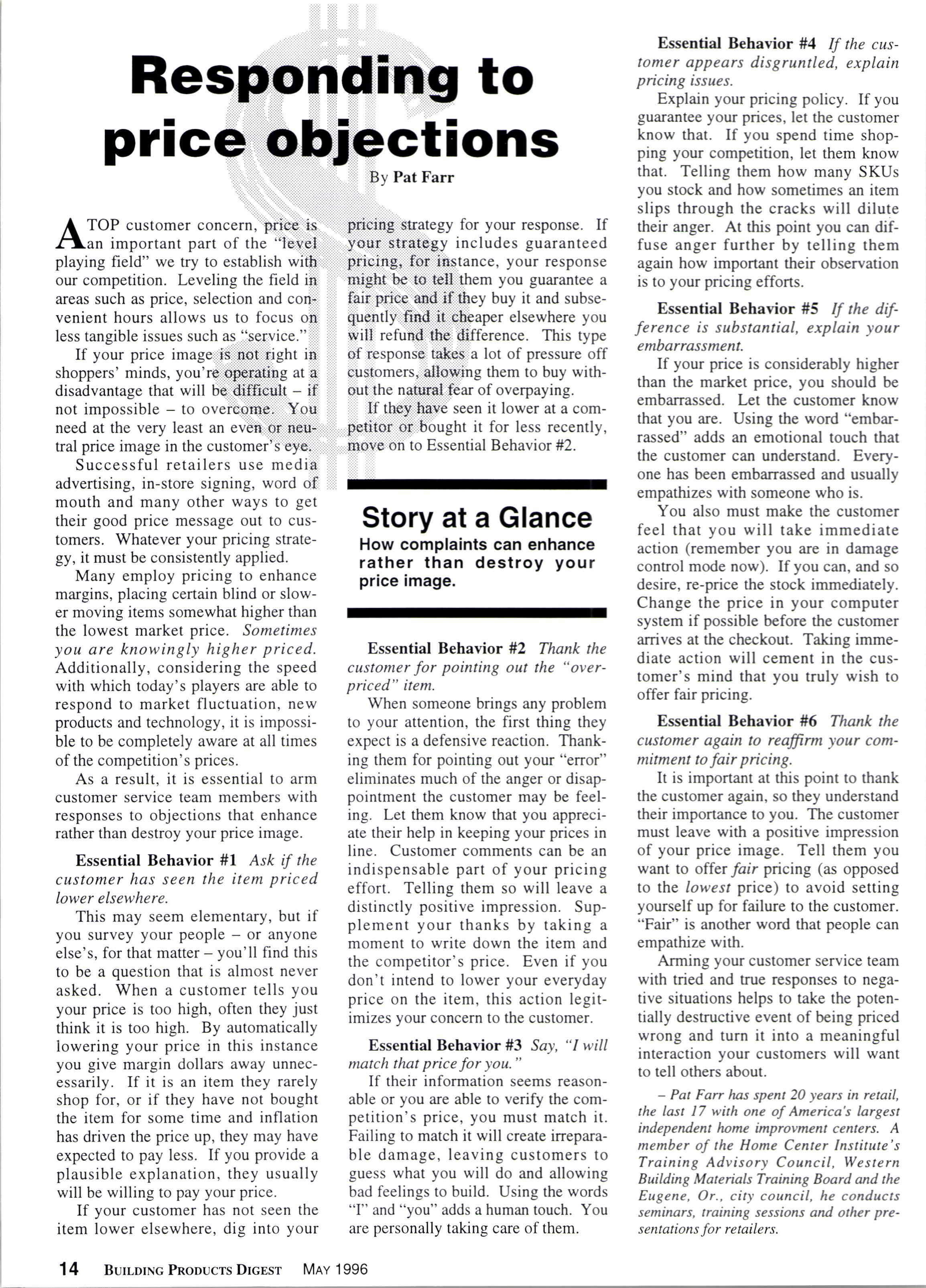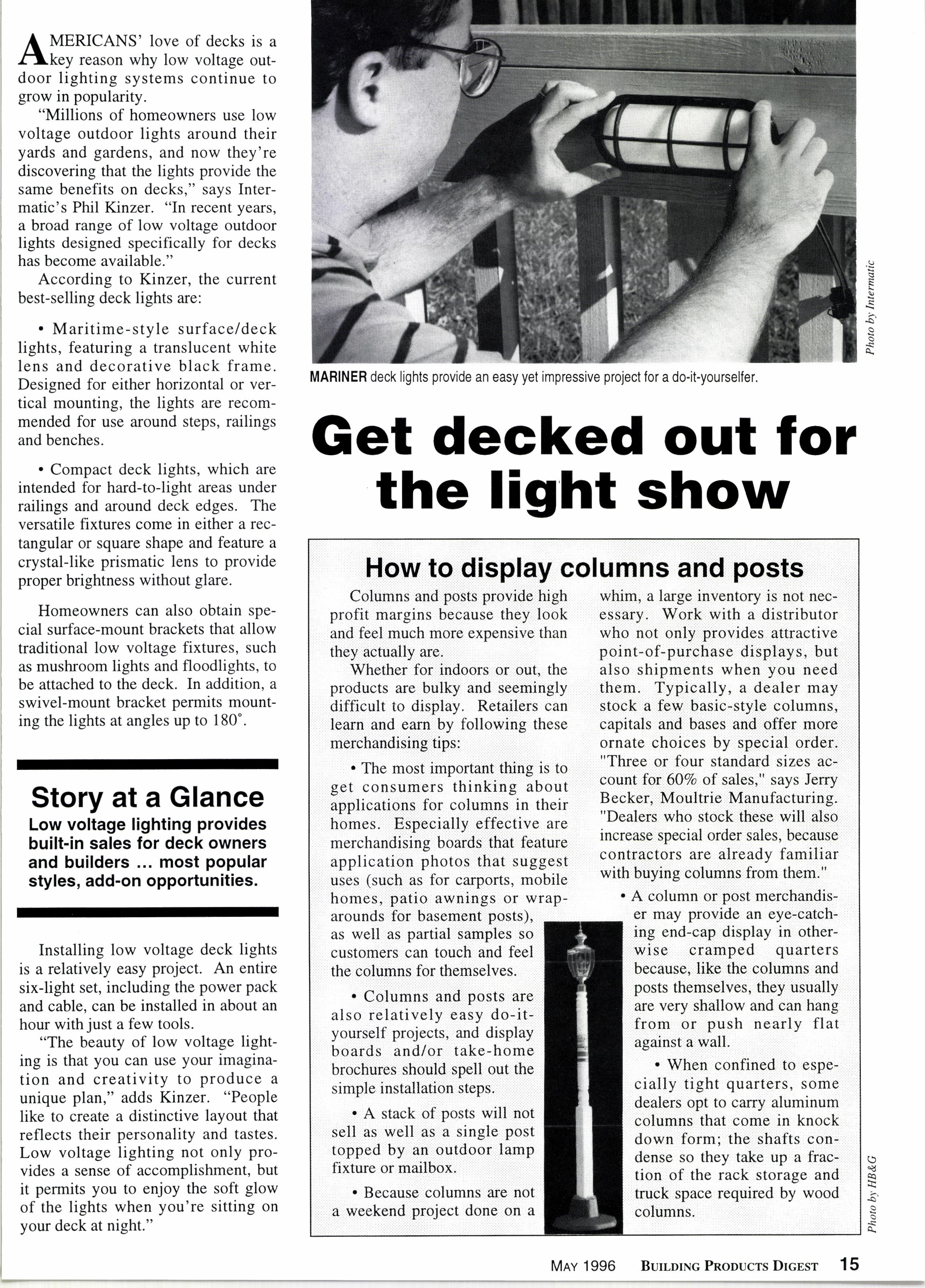
5 minute read
nding to prrce o :bctions
A TOP customer concern, ::pritx::,ii la,an important part of the '1evel:: playing field" we try to establish with:,,:::: our competition. Leveling the field in, areas such as price, selection and con+ venient hours allows us to focus ou: less tangible issues such 45 '15s1viss." ii,:,
If your price image,:,.is:'i,a6l.i.:tl ght iu,, shoppers' minds, you're11 ting at,a, disadvantage that will be:,.dif$eil1t - !f. not impossible - to oveiCome:; You: need at the very least an even:,br,neu+,,,, tral price image in the customer'i eye:,,,,,,,,,,,
Successful retailers use media advertising, in-store signing, word of; mouth and many other ways to get their good price message out to customers. Whatever your pricing strategy, it must be consistently applied.
Many employ pricing to enhance margins, placing certain blind or slower moving items somewhat higher than the lowest market price. Sometimes you are knowingly higher priced. Additionally, considering the speed with which today's players are able to respond to market fluctuation. new products and technology, it is impossible to be completely aware at all times of the competition's prices.
As a result, it is essential to arm customer service team members with responses to objections that enhance rather than destroy your price image.
Essential Behavior #l Ask if the customer has seen the item priced lower elsewhere.
This may seem elementary, but if you survey your people - or anyone else's, for that matter - you'll find this to be a question that is almost never asked. When a customer tells you your price is too high, often they just think it is too high. By automatically lowering your price in this instance you give margin dollars away unnecessarily. If it is an item they rarely shop for, or if they have not bought the item for some time and inflation has driven the price up, they may have expected to pay less. If you provide a plausible explanation, they usually will be willing to pay your price.
If your customer has not seen the item lower elsewhere, dig into your tsy Pat Farr :.:.....:................... i;i;.;. If ltm;4:;:ffit€ seen it lower at a com$etit ,.,oi.,.Sbught it for less recently, ,EtoVs,.on to Essential Behavior #2.
,plifig.,.strategy for your response. If ,ytltll.:.ti$tli*te,gy i ncludes guaranteed ipfidjftgl,i,if ::::lnstance, your response E ightr,,be.i.j(6.,,toll,;,1hem you guarantee a faii..p.{9''e",,'add,.if.,they buy it and subseouently.,1fiffi:,:.+i.i:ffiup"t elsewhere you *ill refuiidr:,ths: difference. This type Of ,responsu: Ef$,,,u lot of pressure off eu$iomers,,:,allowing them to buy without the nahral:fCar of overpaying.
Story at a Glance
How complaints can enhance rather than destroy your price image.
Essential Behavior #2 Thank the customer for pointing out the "overpriced" item.
When someone brings any problem to your attention, the first thing they expect is a defensive reaction. Thanking them for pointing out your "error" eliminates much of the anger or disappointment the customer may be feeling. Let them know that you appreciate their help in keeping your prices in line. Customer comments can be an indispensable part of your pricing effort. Telling them so will leave a distinctly positive impression. Supplement your thanks by taking a moment to write down the item and the competitor's price. Even if you don't intend to lower your everyday price on the item, this action legitimizes your concern to the customer.
Essential Behavior #3 Say, "l will match that pice for you."
If their information seems reasonable or you are able to verify the competition's price, you must match it. Failing to match it will create ineparable damage, leaving customers to guess what you will do and allowing bad feelings to build. Using the words "I" and "you" adds a human touch. You are personally taking care of them.
Essential Behavior #4 If the customer appears disgruntled, explain picing r'ssues.
Explain your pricing policy. If you guarantee your prices, let the customer know that. If you spend time shopping your competition, let them know that. Telling them how many SKUs you stock and how sometimes an item slips through the cracks will dilute their anger. At this point you can diffuse anger further by telling them again how important their observation is to your pricing efforts.
Essential Behavior #5 If the difference is substantial, explain your embanassment.
If your price is considerably higher than the market price, you should be embarrassed. Let the customer know that you are. Using the word "embarrassed" adds an emotional touch that the customer can understand. Everyone has been embarrassed and usually empathizes with someone who is.
You also must make the customer feel that you will take immediate action (remember you are in damage control mode now). If you can, and so desire, re-price the stock immediately. Change the price in your computer system if possible before the customer arrives at the checkout. Taking immediate action will cement in the customer's mind that you truly wish to offer fair pricing.
Essential Behavior #6 Thank the customer again to reaffirm your commitment to fair pricing.
It is important at this point to thank the customer again, so they understand their importance to you. The customer must leave with a positive impression of your price image. Tell them you want to offer fair pricing (as opposed to the /owesr price) to avoid setting yourself up for failure to the customer. "Fair" is another word that people can empathize with.
Arming your customer service team with tried and true responses to negative situations helps to take the potentially destructive event of being priced wrong and turn it into a meaningful interaction your customers will want to tell others about.
- Pat Fan has spent 20 years in retail, the last 17 with one of America's largest independent home imprownent centers. A member of the Home Center Institute's Training Advisory Council, Western Building Mateials Training Board and the Eugene, Or., city council, he conducts seminars, training sessions and other presentations for retailers.
A MERICANS' Iove of decks is a la.key reason why low voltase outdoor lighting ryri"ttn contiiue to grow in popularity.
"Millions of homeowners use low voltage outdoor lights around their yards and gardens, and now they're discovering that the lights provide the same benefits on decks," says Intermatic's Phil Kinzer. "In recent years, a broad range of low voltage outdoor lights designed specifically for decks has become available."

According to Kinzer, the current best-selling deck lights are:
. Maritime-style surface/deck lights, featuring a translucent white lens and decorative black frame. Designed for either horizontal or vertical mounting, the lights are recommended for use around steps, railings and benches.
Compact deck lights, which are intended for hard-to-light areas under railings and around deck edges. The versatile fixtures come in either a rectangular or square shape and feature a crystal-like prismatic lens to provide proper brightness without glare.
Homeowners can also obtain special surface-mount brackets that allow traditional low voltage fixtures, such as mushroom lights and floodlights, to be attached to the deck. In addition, a swivel-mount bracket permits mounting the lights at angles up to 180".
Story at a Glance
Low voltage lighting provides built-in sales for deck owners and builders most popular styles, add-on opportunities.
Installing low voltage deck lights is a relatively easy project. An entire six-light set, including the power pack and cable. can be installed in about an hour with just a few tools.
"The beauty of low voltage lighting is that you can use your imagination and creativity to produce a unique plan," adds Kinzer. "People like to create a distinctive layout that reflects their personality and tastes. Low voltage lighting not only provides a sense of accomplishment, but it permits you to enjoy the soft glow of the lights when you're sitting on your deck at night."










